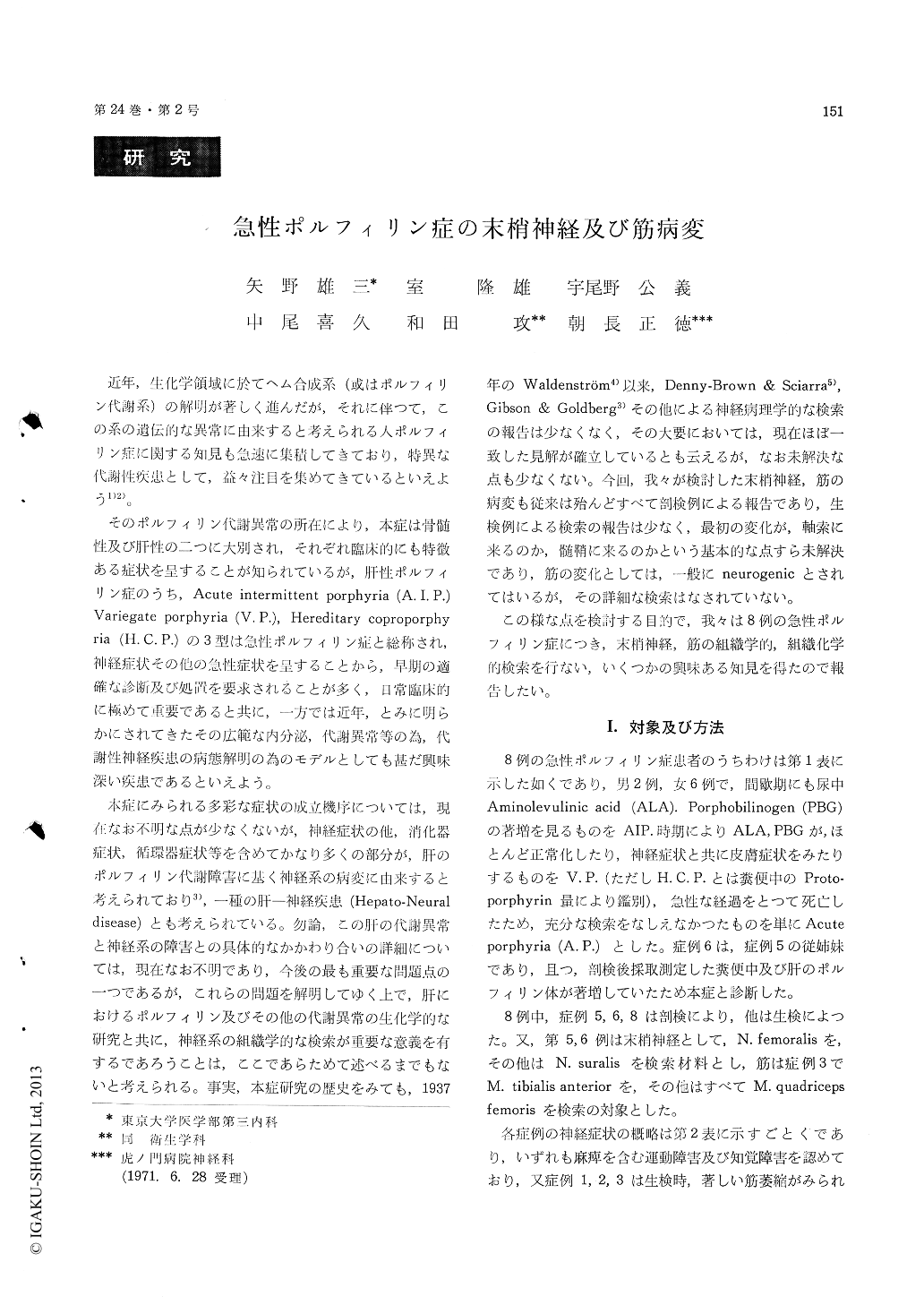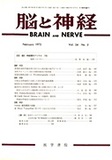Japanese
English
- 有料閲覧
- Abstract 文献概要
- 1ページ目 Look Inside
近年,生化学領域に於てヘム合成系(或はポルフィリン代謝系)の解明が著しく進んだが,それに伴つて,この系の遺伝的な異常に山来すると考えられる人ポルフィリン症に関する知見も急速に集積してきており,特異な代謝性疾患として,益々注目を集めてきているといえよう1)2)。
そのポルフィリン代謝異常の所在により,本症は骨髄性及び肝性の二つに大別され,それぞれ臨床的にも特徴ある症状を呈することが知られているが,肝性ポルフィリン症のうち,Acute intermittent porphyria (A.I. P.)Variegate porphyria (V. P.),Hereditary coproporphyria (H.C.P.)の3型は急性ポルフィリン症と総称され,神経症状その他の急性症状を呈することから,早期の適確な診断及び処置を要求されることが多く,日常臨床的に極めて重要であると共に,一方では近年,とみに上男らかにされてきたその広範な内分泌,代謝異常等の為,代謝性神経疾患の病態解明の為のモデルとしても甚だ興味深い疾患であるといえよう。
There has been many reports on pathological findings in peripheral nerves and muscles in patients with acute porphyria. But most of those studies are based on autopsy samples rather than on biopsy materials, and there remain undissolved some pro-blems of earlier changes in peripheral nerves as well as in muscles.
In this paper, some interesting changes in 5 biopsy cases (No. 1, 2, 3, 4, 7) and in 3 autopsy cases (No. 5, 6, 8) are demonstrated. The type of porphyria of these cases were determined by chemical analysis of porphyrins and its precursors in urine and feces, and the patients diagnosed as acute porphyria (A. P.) were the cases that could not be classified for their too rapid progression to death.
As for the peripheral nerve, N. suralis in 6 cases and N. femoralis in 2 cases (No. 5, 6) were studied and M. quadriceps femoris in all but one case (No. 3) were studied for muscle changes in this disease. In case No. 3, M. tibialis anterior was chosen for material.
The results of this study are as follows ;
1) pathological findings in peripheral nerves
In almost all the cases, some axonal changes of swelling, fragmentation or degeneration are observed with or without myelin degeneration of various degree, and these changes are sometimes accompani-ed with endoneural fibrosis but are not seen any proliferation of schwann cells. Teased fibers obtained from the cases (No. 4, 8) show paranodal and seg-mental demyelinations together with the pictures of Wallerian degeneration of axis cylinders. It seems to be worth while to emphasize that, although only minimum changes of axonal swelling are seen by routine microscopic examination in case No. 4, segmental demyelination is definitely revealed with Wallerian degeneration in teased nerve fibers. These findings seem to indicate that nerve-teasing methodis valuable for the examination of early changes of peripheral nerves. However, there is no relation-ship between the degree of the histological changes and the clinical manifestations among these cases. One of the reasons of this discrepancy may be that most of the materials in this series are N. suraris, which belongs to sensory nerve.
2) pathological findings in muscle fibers
In all cases except for No. 6 & 7, the pictures of neurogenic atrophy of fascicular type and/or of diffuse angulated fibers are found as previously re-ported. Furthermore, in addition to these neuro-genic atrophy, various degree of myogenic changes of muscle fibers such as random variation in fiber size, vacuolar and hyaline degeneration, necrosis with phagocytosis and central nuclei are observed. In addition to histological findings, histochemical studies on succinic dehydrogenase and phosphorylase also reveal the existence of various type of myogenic changes such as subsarcolemmal hyperactivity, ap-pearance of necrotic fibers, moth-eaten-like picture and ringed fiber.
3) pathological findings in blood vessels
In some cases, there are thickening of the wall of small sized blood vessels with or without peri-vascular infiltration of mononuclear cells. But these changes are slight and rather rare, so that it seems to be difficult to assert the significance of these changes. It may be due to some metabolic distur-bance in porphyria.
In conclusion, we find neither any specific pictures of peripheral nerves or muscles in porphyric neuro-pathy nor any differences in these changes between acute intermittent porphyria (A. I. P.) and variegate porphyria (V. P.). In order to elucidate the nature of porphyric neuropathy and myopathy, it is neces-sary to study on the lesions of peripheral nerves and muscles in further cases and in the earlier stages of the disease.

Copyright © 1972, Igaku-Shoin Ltd. All rights reserved.


